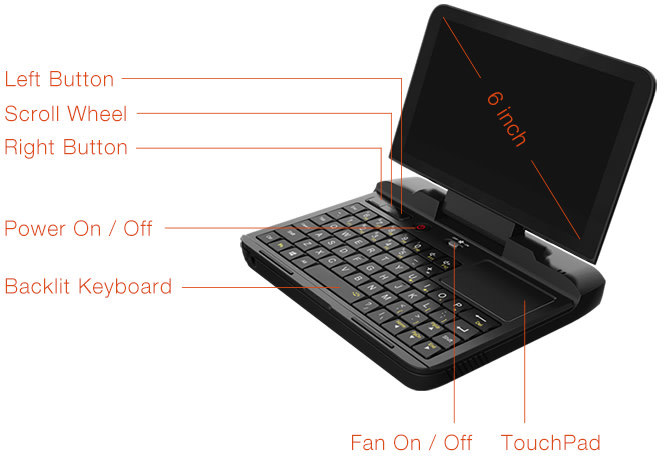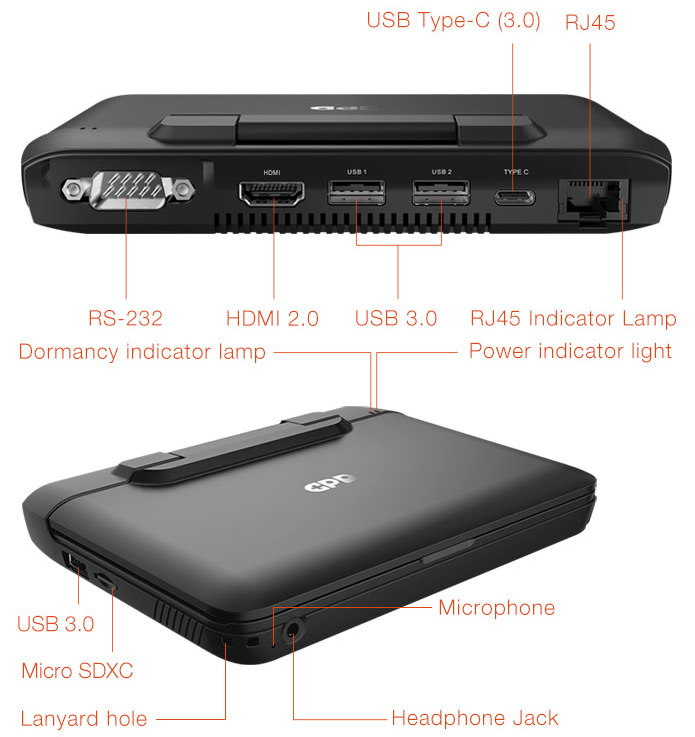I shortly discussed GPD MicroPC, a portable computer specifically designed for for network engineers and sysadmins in a post about the company’s Pocket 2 Amber Black mini laptop, but I did not go into details at the time since it was not available.
GPD has now launched a crowdfunding campaign on Indiegogo for the portable Gemini Lake mini PC, where you can pick one of the 2,000 units that are available for $299 including worldwide shipping.
GPD MicroPC specifications:
- SoC – Intel Celeron N4100 quad core Gemini Lake processor with Intel UHD Graphics 600
- System Memory – 4GB LPDDR4
- Storage – Replaceable 128GB M.2 2242 SATA SSD, micro SDXC card slot
- Display – 6″ display with 1280×720, Gorilla Glass 4, 178° viewing angle
- Video Output – HDMI 2.0 up to 4K @ 30 Hz
- Audio – Built-in microphone, headphone jack, digital audio via HDMI
- Networking
- Gigabit Ethernet
- 802.11 a/b/g/n/ac WiFi 5
- Bluetooth 4.2
- USB – 3x USB 3.0 type A host ports, 1x USB 3.0 type-C port
- Serial – 1x RS-232 port
- User Inputs – Backlit QWERTY keyboard, Touchpad + left and right button + scroll wheel
- Sensor – Hall Sensor
- Misc – Power button, fan button, “dormancy” and power LEDs, lanyard hole, two copper nuts at the back for mounting
- Battery – 2x 3100mAh LiPo batteries in series good for about 6 to 8 hours
- Dimensions – 153×113×23.5mm
- Weight – 440g
The actively cooled mini PC comes with Windows 10 Pro, but the company claims to have a strategic cooperation with Ubuntu MATE, and users will be able to download and install Ubuntu MATE 18.10 from the GPD official website and crowdfunding update area.
The device will ship with a USB-C power adapter (5V/3A, 9V/2.67A, 12V/2A, 15V/1.6A), a warranty card (one year), and a specification sheet. Delivery is expected for August 2019, and price will go up to $399 on it sells for retail.
GPD sent early samples to several reviews, and for instead, Liliputing tested both Windows 10 and Ubuntu, and he ran into troubles installing the non-customized version of Ubuntu, with MicroPC’s Ubuntu MATE 18.10 having yet to be released. Brad Linder also reports GPD MicroPC is the cheapest “mini laptop” you can buy, with many ports, but the lack of webcam and touchscreen may be an issue for some people.
The Phawx also posted several videos about GPD MicroPC, including the review embedded below.

Jean-Luc started CNX Software in 2010 as a part-time endeavor, before quitting his job as a software engineering manager, and starting to write daily news, and reviews full time later in 2011.
Support CNX Software! Donate via cryptocurrencies, become a Patron on Patreon, or purchase goods on Amazon or Aliexpress






